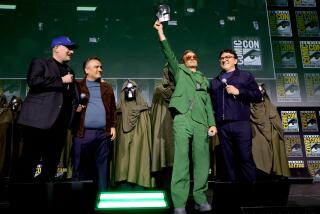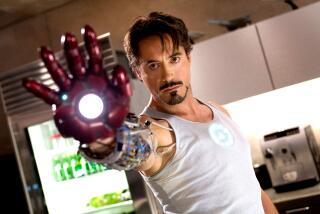Director Peyton Reed says he’ll show you how Ant-Man is cool
- Share via
There are the superheroes everyone knows and loves, the ones kids dress up as for Halloween, the ones whose logos and square-jawed faces are emblazoned on everything from lunchboxes to dorm-room posters to tighty-whities.
And then there is Ant-Man.
The Marvel Comics hero — whose suit enables him to shrink to microscopic size and communicate with ants — boasts an illustrious nearly 50-year history and was a founding member of the Avengers. But in terms of mainstream awareness, Ant-Man is to marquee heroes like Batman and Spider-Man roughly what a bug is to an elephant.
Marvel Studios President Kevin Feige has a simple explanation for that: “He hasn’t had a movie yet. He hasn’t made his debut.”
With “Ant-Man,” the character is finally ready for his (extremely zoomed-in) close-up.
The film stars Paul Rudd as Scott Lang, a thief and ex-con who becomes the protege of Hank Pym (Michael Douglas), creator of the Ant-Man technology. But as befitting an unconventional superhero, “Ant-Man” is far from a typical origin tale, according to director Peyton Reed, best known for such comedies as “Bring It On” and “Yes Man.”
“It’s a sort of a dual redemption story between two guys and their daughters with the structure of a heist movie with a science-fiction concept but with a real comedic rhythm to it,” Reed said. He laughed. “You know, one of those movies.”
If that log line sounds complicated, the history of the project is even more tangled. The idea of an “Ant-Man” movie first arose in the late 1980s but didn’t pick up steam until 2006, when Marvel hired Edgar Wright — the director of quirky genre deconstructions like “Shaun of the Dead” and “Hot Fuzz” — to bring his own script, co-written with Joe Cornish, to the screen.
After years of development, the film was on the brink of starting production in May 2013 when Marvel and Wright jointly announced that Wright was leaving the project because of “differences in their vision of the film.” With a release date in place but no director or approved script, comic-book fans — many of whom had been excited over the prospect of Wright’s film — wondered if “Ant-Man” could end up being squashed.
“There was a lot of scrambling to just figure out what the next step would be,” said Rudd, who quickly helped recruit writer-director Adam McKay, with whom he’d worked on the “Anchorman” films, to collaborate on a new draft of the script. Within weeks, Reed — who had earlier been in the running to helm “Guardians of the Galaxy” — signed on to direct the film.
“It’s easy to look at that time and say it was chaotic,” said Rudd, who put in months of training to develop a more superheroic physique. “But while [Wright’s exit] was obviously a personal bummer — I’m an Edgar fan and I’m here because of him — there are also a lot of positive things that happened as a result. No. 1 being that we got Peyton.”
A die-hard comics fan since childhood, Reed didn’t run away from Ant-Man’s relative obscurity — in fact, he fully embraced it. “I like the idea that he’s one of the lesser-known characters out in the world,” he said. “I find something sort of liberating about that. People don’t really know what to make of him: ‘He shrinks and he controls ants — how is that cool?’ We’re going to show you absolutely how that’s cool.”
Although comic-book movies can often be rather ponderous in tone — saving the world, after all, is serious business — the team behind “Ant-Man” knew there was something inherently ridiculous about a superhero who can be sucked into a vacuum cleaner or trampled underfoot on a dance floor and incorporated that absurdity into the film on a fundamental level.
“Because it’s Ant-Man, the action sequences have the real jeopardy that you’d want but they also have a comedic bent,” Reed said. “When you’re down in that micro world it’s intense, but then you pop out and look at it from the real-world perspective and it feels really mundane. Shifting between those perspectives is a great comedic runner in the movie.”
Indeed, although the scale the film’s action takes place on is very small — thanks to a combination of macrophotography and motion capture — the stakes for the characters are not, Feige said. “I love that in the climax of this film it’s not a giant city being lifted into the sky by an army of intelligent robots — it’s two characters fighting at the size of about half an inch in a little girl’s bedroom on a train play set. That felt like an opportunity do something equally thrilling but a little different.”
As for the stakes for Marvel and its parent, the Walt Disney Co., though “Ant-Man” has been called one of the riskiest major superhero films yet, Feige isn’t sweating it. The film had a production budget in the neighborhood of $130 million — or roughly half of what the gargantuan “Avengers: Age of Ultron” cost — and is on track to open at $60 million to $65 million. That would put it on par with the debuts of Marvel’s first “Captain America” and “Thor” films, even though those characters are far better known.
In a clear vote of confidence, Ant-Man is already set to make an appearance in Marvel’s next film, “Captain America: Civil War.”
“I’m excited about presenting a film that can surprise people,” Feige said. “It’s great seeing people being won over to the idea of a Norse god with a hammer who’s from another planet or a bunch of intergalactic bandits, one of whom is a tree and another of whom is a talking raccoon. To be met with skepticism until people see the movie — that is actually my comfort zone.”
More to Read
The biggest entertainment stories
Get our big stories about Hollywood, film, television, music, arts, culture and more right in your inbox as soon as they publish.
You may occasionally receive promotional content from the Los Angeles Times.











